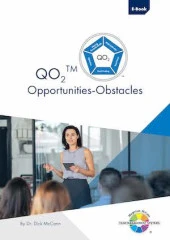Opportunities-Obstacles Quotient Profile (QO2)
Is your glass half-empty or half-full? The Opportunities-Obstacles Quotient Profile looks at people's approach to risk and determines the balance of effort put into seeing the opportunities and obstacles at work. Some people have a higher risk acceptance than others and may see only the opportunities, often ignoring the obstacles. Others may be risk averse and see only the obstacles, ignoring the possibilities of new projects or ventures.
The Risk-Orientation Model
Five subscales form the basis of the Opportunities-Obstacles Quotient (QO2) methodology and comprise the Risk-Orientation Model. All scales have undergone a rigorous research program and have high face validity and utility for managers and their teams. The five subscales are:
MTG Energy - how much energy you put into 'Moving Towards your Goals'.
Multi-Pathways - the extent to which you find ways around obstacles
Fault-Finding - how good you are at seeing potential obstacles
Optimism - the extent to which you expect positive outcomes
Time-Focus - a measure of your psychological time and your orientation to the past, the present or the future
The Profile enables individuals to review their approach to work and improve both the way they seize opportunities and foresee obstacles. An overall score on the instrument is given together with data on the five subscales.
The Opportunities-Obstacles Quotient Profile is invaluable for:
- Personal development
- Team development
- Change management
- Conflict resolution
- Finding ways around obstacles
- Potential obstacle analysis
The Opportunities-Obstacles Quotient Profile and the Team Management Profile together give five-factor feedback to rival the best clinical personality instruments. The difference is the focus placed on work. You will learn how to harness your own uniqueness and to get the most out of your work life.
In their 2006 review of the Opportunities-Obstacles Quotient Profile, the British Psychological Society concluded that “the QO2 provides a reliable measure of a construct with high face validity. Knowledge of one’s own position with regard to seeing opportunities or obstacles relative to the stance of others should be helpful in both personal and team development. This will be particularly important during periods of change and turnaround that have now become almost a constant feature of organisational life. The measure will probably be used most as an adjunct to the TMPQ for team building and development work and it is well-suited for that purpose.”
July
Webinar
10 | Opportunties-Obstacles Quotient (QO2) Profile Accreditation
Webinar | UK | More about Opportunities-Obstacles Quotient (QO2) Profile
Open
Webinar
10 | Opportunties-Obstacles Quotient (QO2) Profile Accreditation
Webinar | US | More about Opportunities-Obstacles Quotient (QO2) Profile
Open
August
Webinar
07 | Opportunities-Obstacles Quotient (QO2) Profile Accreditation
Webinar | AU | More about Opportunities-Obstacles Quotient (QO2) Profile
Open
September
Webinar
04 | Opportunities-Obstacles Quotient (QO2) Profile Accreditation
Webinar | AU | More about Opportunities-Obstacles Quotient (QO2) Profile
Open
Webinar
23 | Opportunties-Obstacles Quotient (QO2) Profile Accreditation
Webinar | UK | More about Opportunities-Obstacles Quotient (QO2) Profile
Open
Webinar
23 | Opportunties-Obstacles Quotient (QO2) Profile Accreditation
Webinar | US | More about Opportunities-Obstacles Quotient (QO2) Profile
Open
October
Webinar
02 | Opportunities-Obstacles Quotient (QO2) Profile Accreditation
Webinar | AU | More about Opportunities-Obstacles Quotient (QO2) Profile
Open
November
Webinar
12 | Opportunties-Obstacles Quotient (QO2) Profile Accreditation
Webinar | UK | More about Opportunities-Obstacles Quotient (QO2) Profile
Open
Webinar
12 | Opportunties-Obstacles Quotient (QO2) Profile Accreditation
Webinar | US | More about Opportunities-Obstacles Quotient (QO2) Profile
Open


